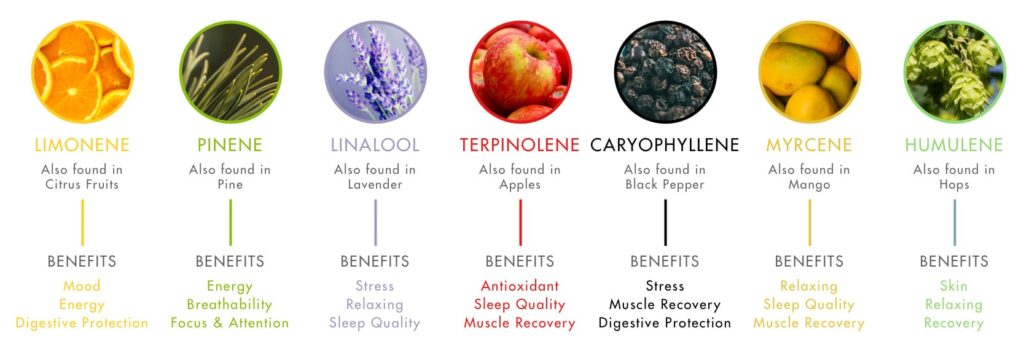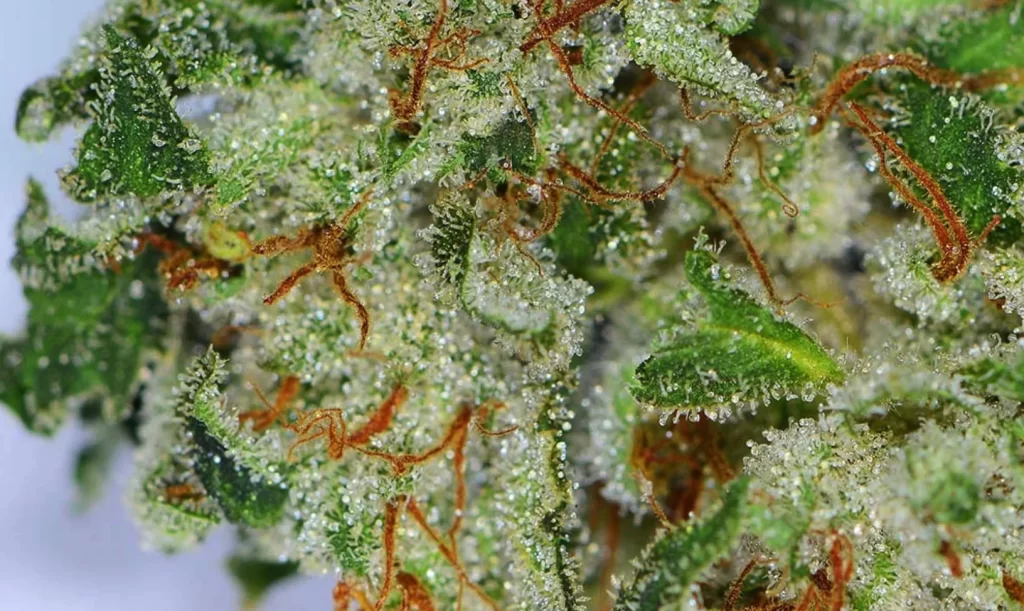- You have no items in your shopping cart
- Continue Shopping

What are cannabis terpenes?
Terpenes are the aromatic compounds that determine the scent of many flowers and herbs, bestow cannabis with its distinctive odor and contribute to its flavor. Cannabis contains more than 150 types of terpenes. Although most terpenes are present in only trace amounts, the more prominent ones team together to give diverse cannabis strains their signature scent profiles. The combination of terpenes in Sour Diesel tell you of its pungent, gassy character, while Cherry Pie evokes the pleasant scent of sweet and sour cherry pie fresh out of the oven. Beyond providing cannabis with its unique bouquet of scents, terpenes also hold diverse functions in the plant and can produce a range of therapeutic and mood-altering effects in cannabis consumers.
Where do terpenes come from?
Terpenes are naturally-occurring compounds found in the trichomes of female cannabis plants. Trichomes are sticky, translucent glands that cover the surface of buds, and in much smaller amounts, on leaves and stems. Critically, trichomes contain resin glands that produce terpenes. Terpenes play an integral role in a cannabis plant’s growth and survival. Besides producing distinctive aromas, these organic compounds also enrich color and pigmentation in leaves and buds, and contribute to the flavor of cannabis. In short, terpenes help to enhance the plant’s attractiveness to some creatures, while deterring others that can do harm. A sweep of variables can affect the amount of terpenes a cannabis plant produces. Factors such as whether the plant is grown outdoors or indoors, exposure to light, temperature, certain growing mediums, nutrient levels, and when harvesting is carried out can all influence terpene levels.
How do terpenes affect the body?
The effects of terpenes appear to extend beyond feel-good benefits and stress relief. Terpenes have also been identified as a new frontier in cannabis medicine. Until recently, the spotlight has been focused almost exclusively on the therapeutic qualities of cannabinoids, such as THC and CBD, but as our understanding of terpenes grows more sophisticated, it’s becoming apparent that these aromatic compounds are medicinal powerhouses too. All terpenes boast unique combinations of therapeutic properties. Unsurprisingly, some of the effects terpenes have on humans are evocative of their function in cannabis and other plants—like helping to fight off unwelcome microbes and pathogens.
The medicinal benefits:
Antiviral
- Researchers are always on the hunt for new antiviral compounds. Many terpenes could show strong abilities to help kill viruses, including alpha- and beta-pinene, caryophyllene, camphor, and carvone.
Anticancer
- Rising rates in many forms of cancer are driving the quest to find compounds that can help suppress it. Some terpenes, including those found in cannabis, can exhibit anticancer activity, helping to inhibit the activity or growth of cancer cells.
- Limonene could represent a particularly notable anticancer and antitumor agent, along with other terpenes such as pinene, camphor, terpinene, and beta-myrcene. One potential unique benefit of terpenes is that they may be unlikely to affect healthy cells or cause side effects—something important for cancer treatments.
Antidepressant
- Twenty-five percent of antidepressant drugs are formulated using herbal extracts that contain terpenes. Linalool and beta-pinene are common among many plant extracts used in antidepressant medication.
Antimicrobial
- A vast array of terpenes may display antimicrobial activity, or the ability to halt a harmful microorganism in its tracks. Terpenes that may help in killing or stopping the progression of microorganisms include alpha-bisabolol, geraniol, menthol, eucalyptol, and terpinolene.
Pain relief
- Researchers have found that some cannabis terpenes may mimic cannabinoids by creating a pain-relieving effect. In one 2021 study that combined terpenes with cannabinoids, pain-relieving effects were amplified without an increase in negative side effects. This interaction could indicate the entourage effect (more below).
- Terpenes that may promote pain-relieving activity include humulene, geraniol, linalool, and β-pinene. Fascinatingly, the study above also found that these terpenes activate the body’s CB1 receptors, which form part of the endocannabinoid system and influence pain perception.

The top three terpenes found in cannabis
As mentioned earlier, there’s a staggering range of terpenes present in cannabis—more than 150 different types, to be exact. While many of these occur in concentrations too low to detect, some have a more robust presence. Here’s the lowdown on three terpenes that are the most predominant in cannabis:
1) Myrcene
Most cannabis cultivars are dominant in either myrcene or caryophyllene. Myrcene, a terpene that’s also predominant in hops and lemongrass, has been described as delivering scent notes that are herbaceous, spicy, earthy, and musky. Myrcene gives cannabis a mildly sweet flavor profile—it’s also found in mangoes.
In addition to contributing to the signature scent of cannabis, myrcene can also deliver anti-inflammatory effects. A 2015 study in cultured cells indicates that myrcene may effectively reduce inflammation associated with osteoarthritis. The terpene also appeared to help prevent the breakdown of cartilage cells, slow down the progression of osteoarthritis, and decrease the production of certain inflammatory cells produced by the body. Myrcene could potentially be harnessed to help alleviate anti-inflammatory diseases and their symptoms in the future.
2) Caryophyllene
Caryophyllene, also known as beta-caryophyllene or β-caryophyllene, lends a spicy, peppery bite to some cannabis strains. Caryophyllene is also found in other plants such as cloves, rosemary, oregano, and black pepper. If you catch any of these scents when you smell a certain cannabis cultivar, it’s likely because caryophyllene is present.
Caryophyllene is the only known terpene found in cannabis that can bind to the CB2 receptor in the endocannabinoid system, which is found in the body’s immune system. Thanks to this unique action, caryophyllene is sometimes also classed as an atypical cannabinoid. Research into the therapeutic actions of caryophyllene shows that it has potential in easing symptoms in diverse conditions such as colitis, diabetes, cerebral ischemia, anxiety and depression, liver fibrosis, and Alzheimer-like diseases. Future research suggests that caryophyllene’s activity at the CB2 receptor could be harnessed to help treat conditions that are accompanied by inflammatory symptoms.
3) Limonene
Clean, fresh, uplifting citrus-y scents—limonene’s name is a giveaway for the aromas associated with this terpene. Limonene is found in the rinds of citrus fruits and ginger, and the terpene is also predominant in many cannabis cultivars that have a fruity, fresh bouquet, like Papaya Punch or Black Cherry Soda.
Limonene appears to alter the way certain immune cells in the body behave, which may protect the body from a range of disorders. In one study, limonene helped to increase the production of antibody-producing cells in the spleen and bone marrow, which are used by the immune system to identify and neutralize pathogenic bacteria and viruses.
Author: Emma Stone, November 10, 2021





